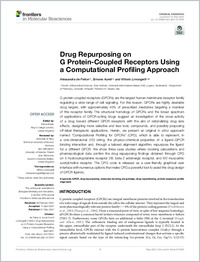Drug repurposing on G protein-coupled receptors using a computational profiling approach
- De Felice, Alessandra ORCID Euler Institute (EUL), Università della Svizzera italiana, Switzerland
- Aureli, Simone ORCID Euler Institute (EUL), Università della Svizzera italiana, Switzerland
- Limongelli, Vittorio ORCID Euler Institute (EUL), Università della Svizzera italiana, Switzerland - Department of Pharmacy, University of Naples “Federico II”, Naples, Italy
- 2021
Published in:
- Frontiers in molecular biosciences . - 2021, vol. 8, p. 673053
English
G protein-coupled receptors (GPCRs) are the largest human membrane receptor family regulating a wide range of cell signaling. For this reason, GPCRs are highly desirable drug targets, with approximately 40% of prescribed medicines targeting a member of this receptor family. The structural homology of GPCRs and the broad spectrum of applications of GPCR-acting drugs suggest an investigation of the cross-activity of a drug toward different GPCR receptors with the aim of rationalizing drug side effects, designing more selective and less toxic compounds, and possibly proposing off-label therapeutic applications. Herein, we present an original in silico approach named “Computational Profiling for GPCRs” (CPG), which is able to represent, in a one-dimensional (1D) string, the physico-chemical properties of a ligand–GPCR binding interaction and, through a tailored alignment algorithm, repurpose the ligand for a different GPCR. We show three case studies where docking calculations and pharmacological data confirm the drug repurposing findings obtained through CPG on 5-hydroxytryptamine receptor 2B, beta-2 adrenergic receptor, and M2 muscarinic acetylcholine receptor. The CPG code is released as a user-friendly graphical user interface with numerous options that make CPG a powerful tool to assist the drug design of GPCR ligands.
- Collections
- Language
-
- English
- Classification
- Pharmacology, therapeutics, toxicology
- License
- Open access status
- gold
- Identifiers
-
- DOI 10.3389/fmolb.2021.673053
- ARK ark:/12658/srd1328323
- Persistent URL
- https://n2t.net/ark:/12658/srd1328323
Statistics
Document views: 87
File downloads:
- De Felice_2021_fmolb: 50
